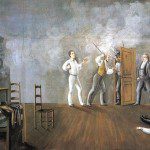Chef James Beard is a hero of mine. His prose is clean, content-rich, and full of wry opinion. He honored history and tried to be an Everyman. Beard’s manifesto in favor of ham as party food changed me forever.[i]
Imagine my pleasure, then, when I learned he’d written a cookbook entitled, How to Eat Better for Less Money. I opened the book to discover an entire chapter devoted to the concept of an “Emergency Shelf.”[ii]
Culinary preparation for an emergency is a central part of my heritage. From the time the Latter-day Saint (LDS) pioneers first successfully harvested their crops in the Salt Lake Valley, Brigham Young encouraged them to store up the excess for future times of famine. In 1876, Young asked Woman’s Exponent newspaper editor Emmeline B. Wells to publish editorials with an appeal to women to save wheat. A few weeks later Eliza R. Snow, the leader of the Relief Society (the LDS Church’s women’s organization), organized a Central Grain Committee with Wells as chairman. [iii] The committee coordinated grain-saving activities throughout the Relief Society for the next several decades. Saving wheat became so synonymous with Relief Society work that artist Jack Sears added sheaves of wheat to his redesign of the Relief Society seal in 1941. [iv]
In 1940, the General Relief Society President, Amy Lyman Brown, the Presiding Bishop, Joseph L. Wirthlin, and head of the welfare system, Harold B. Lee, formed a wheat committee as part of the larger Church Welfare Program. The Relief Society would provide wheat, the welfare system would provide storage facilities, and the Church would pay to store and care for the wheat. By 1943, Church grain storage elevators in Salt Lake City and Sharp, Utah, and McCannon, Idaho, held nearly 300,000 bushels of wheat.[v]
Today we are taught, “[Heavenly Father] has lovingly commanded us to ‘prepare every needful thing’ (see D&C 109:8) so that, should adversity come, we may care for ourselves and our neighbors and support bishops as they care for others. We encourage members worldwide to prepare for adversity in life by having a basic supply of food and water and some money in savings.”[vi]
In minds with imaginative tendencies, such teachings can flourish. Growing up, my family consisted of three members: Mom, Grandma, and me. In my late teens, I was so appalled by what I perceived to be our inadequate emergency preparedness that I pursued one of my lifetime’s top five well-intentioned but most-insensitive acts. I bought an emergency preparedness book (one not published by the Church). It featured a shiny black cover strikingly emblazoned with an apocalpytic lightning bolt.
Carefully studying the charts and recommendations therein, I developed a program detailing what we should buy each month over the course of two years so that we would eventually have a complete, shelf-stable, one-year supply of food. It was the kind of food my mother and grandmother never, ever ate: barley, lentils, powdered milk. I gave them my plan, and the shiny black book, for Christmas. They did not attempt to follow my plan. Not even for a month.
I gradually moved toward adulthood, still nervous about my lack of food storage. After marriage, I found myself haunted by the specter once more. Eventually, I settled on a food storage plan somewhat like current official suggestions. In addition to items intended for long-term storage (of which we still don’t have enough), my family now boasts a three-month supply of everyday items that we rotate, like pasta and black beans. I’ve learned to bottle peaches, tomatoes, quince, jams, chutneys, and beets for our supply. An earthquake would destroy all of my bottled labors, but in the meantime, they nourish us well.
When I came across Beard’s book, I still felt engaged in the search for an ideal food storage plan. I knew that Beard would have good answers. I trusted that his emergency shelf would harbor delicious options for times of stress. Looking up his “Emergency Shelf” chapter felt like the cusp of resolution for my food storage difficulties.
Unfortunately, Beard’s conception of emergency was different than mine. I wanted to prepare for unemployment, power outages, and earthquakes. Salt Lake City sits atop the Wasatch Fault; what would be salvageable from my octogenarian brick bungalow? But instead of teaching me the safest areas to preserve months of supply, Beard described his single shelf: canned tongue, caviar, gefilte fish, lobster, chutney, and liquors. Beard’s idea of an emergency? Unexpected dinner guests.
I didn’t know what to do about Beard’s shelf. I feed my Jewish friends, but none of us likes gefilte fish. (One such friend brought us a pork tenderloin when my last child was born.) Still, having gefilte fish in the pantry might be an important gesture. Beard’s shelf challenged me. I admired it. Beard’s shelf was a reminder to be inclusive. Beard’s shelf focused on the other, on the idea of providing spontaneous pleasure for other people. His shelf was celebratory.
My shelf, on the other hand, reflects a struggle between holding on and letting go. Knowing all the work invested in each bottle, I sometimes feel reluctant to open them too often. Will tonight’s guests realize how hard we worked to forage these elderberries? But lately, I’ve been sharing the contents of our emergency shelf with unusual abandon, something my generous husband is always willing to do. This freer approach to pantry outflows makes me feel a little closer to Beard’s goodness and capacity for celebration.
In general, though, my shelf has provided pleasure of a different sort. My shelf displays the satisfaction of work, what Elaine Jack (General President of Relief Society when she said this in 1993) described as, “magic in getting into a task so thoroughly that you relish the process itself. Maybe that’s why some of us get so much satisfaction from full jars of fruit in a storage room.”[vii] My shelf speaks of security and careful planning. List-keeping. Emergency preparedness. I suspect Beard was better company at dinner parties than I am, but as I am, this is the shelf I have made.
_____
[i] James Beard, James Beard’s Simple Foods (New York: Macmillan, 1993), 201–202.
[ii] James Beard, How to Eat Better For Less Money (New York: Appleton-Century-Crofts, 1954).
[iii] “Store up Grain,” Woman’s Exponent 5:12 [Nov. 15, 1876]:92
[iv] Improvement Era, September 1941, 542.
[v] Jessie L. Embry, “Relief Society Grain Storage Program, 1876-1940” (Master’s Thesis, Brigham Young University, 1974), 67–69.
[vi] http://www.lds.org/family/family-well-being/home-storage?lang=eng
[vii] Elaine L. Jack, “Get a Life”, January 3, 1993, http://speeches.byu.edu/reader/reader.php?id=7097.











